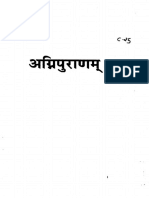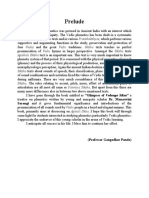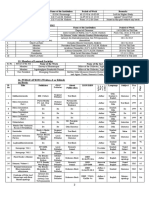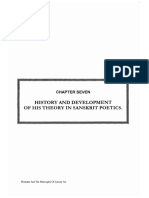0 ratings0% found this document useful (0 votes)
155 viewsContribution of Bengal To Sanskrit
Contribution of Bengal To Sanskrit
Uploaded by
Dr. Sashibhusan MishraHistory
Copyright:
© All Rights Reserved
Available Formats
Download as PDF or read online from Scribd
Contribution of Bengal To Sanskrit
Contribution of Bengal To Sanskrit
Uploaded by
Dr. Sashibhusan Mishra0 ratings0% found this document useful (0 votes)
155 views24 pagesHistory
Original Title
Contribution of Bengal to Sanskrit
Copyright
© © All Rights Reserved
Available Formats
PDF or read online from Scribd
Share this document
Did you find this document useful?
Is this content inappropriate?
History
Copyright:
© All Rights Reserved
Available Formats
Download as PDF or read online from Scribd
Download as pdf
0 ratings0% found this document useful (0 votes)
155 views24 pagesContribution of Bengal To Sanskrit
Contribution of Bengal To Sanskrit
Uploaded by
Dr. Sashibhusan MishraHistory
Copyright:
© All Rights Reserved
Available Formats
Download as PDF or read online from Scribd
Download as pdf
You are on page 1of 24
BENGAL'S CONTRIBUTION TOSANSKRIT LITERATURE
(A chronological frame-work )
BY
CHINTAHARAN CHAKRAVARTI, M. A.
ate
PREFACE
An investigation into the history of Sanskrit literature ina
particular province will be of help not only to build up a con-
nected literary history of the land but also in supplying
important materials for the study of its cultural history. This
purpose is not however served by any study of the history of
Sanskrit literature asa whole, for nocossarily in a general
history of literature-works that haye only a local interest
cannot receive detailed treatment howsoever important those
works may be in the literary history of a particular province,
‘What is of little importance in Sanskrit literature taken as a
whole may be of vital importance with respect to a particular
province. But no comprehensive work dealing with the history
of Sanskrit literature in any particular province has appeared
as yet. Prof. K. R, Pisharoti delivered before the Madras
University a course of lectures on the Kerala contribution
to Sanskrit literature of which the first instalment only
appeared in Shama'a ( October 1928 ).
The study of the history of Sanskrit literature in Bengal
and Bengal's contributions to it are specially interesting.
Bengal has her peculiarities in her ways of life and thought
which are reflected in her religious notions and ritualism. And
she has her peculiarities in her literature too. Besides, the
history of Sanskrit literature in Bengal does not seem to point
to progressive degeneration but apparently thora are traces of
growth slong with the process of time. Fresh developments
are noticed as the centuries roll on, Bengal, as we shall see in
the following pages, had become an important contro of
Sanskrit learning almost from the beginning of the Christian era
and continued to be so all along. And from about th» fifteenth
century she came to be one of the most important- if not the
most important-centres of Sanskrit culture, and produced a
good many works of outstanding merit, It is to be noted that
Bengal seems still to hold her position at least with regard to
some particular branches of study.
236 Annals of the Bhandarkar Oriental Research Institute
A good many Sanskrit works of Bongal have nodoubt been
published either in Nagari or in Bengoli cheractors. But
many more still are to be found only in Mss which supply us
with important materials in our investigations. So the
various Notices, Reports and Catalogues of Sanskrit Mas are of
immense help in this metter. An attempt has boon made to
mako the best use of them, especially those of Bengal as also
the Descriptive Catalouge of Sanskrit Mss in the India Office
Library, London, Besides these, I had the opportunity of
consulting two valuable manuscript collections, namely, (1)
the collection of the Sanskrit Sahitya Parisbat, Caloutta (2)
the private collection of Kumar Sarat Kumar Ray, M. A. of
Dighapatia which is called Saviti Memorial collection in
memory of the eldest son of the Kumira. No catalogue of any
of those collections has as yot beon published.
Some amount of useftl and valuable work on this subject
has already been done. But all this is with reference to
particular periods or partioular topios, Of these the papers of
Mm. Dr. H.P. Shastri on Contributions of Bengal to Hindu
Civilisation and Literay History of the Pala Period (J. B.O.
B.S, 1919), and of the lateManomohsn Chekravarti on
Sanskrit literature in Bengal during the Sena Period (J. A. 8. B.-
1906), History of Navya Nyaya in Bengal and Mithila (5. A. 8.B.
1915) desorve special mention. Much valuable and usoful
information on the subject is also found scattered in the
Prefaces to Mm, H. P. Shastri’s notices and oatalouges as also,
among others, inthe History cf Indian Lome of Dr. 8. 0.
Vidyabhusan, Studies in the History of Sanskrit Poetics of Dr.
8. K. Doand Systems of Sanskrit Grammar of Dr. 8,K. Belvalkar.
No attempt to write a systematio and complete history of
Sanskrit literature in Bengal seems to have as yet been mado
by any scholar, Dr. Md. Shahidullah of theDacoa University,
read a short paper on “ Bengal’s Contribution to Sanskrit
learning’, before the Oriental Conference held in Madras in
1924." But he has not so far published it anywhere.
But there are some difficulties which ono has to face in the
study of the history of Senskrit literature in Bengal, nay, any
particular province. One of these is regarding chronology.
Works of Bengal, like those of other parts of India, seldom
18 of the Thied Oriental Conference, Madras, 1925—
1 Proved
p- XIX,
Bengal’s Contribution to Sanskrit Literature 237
mention dates or locslitios portaining to the authors. And
hence tho difficulty of settling tho chronology is very great
and this is quite well-known, But even more than this is the
difficulty of determining the place of origin of most of the
authors.
In very many cases one has nootherway left for ascertain
ing the Bengal origin of a work than one or more of the
following: { 1) poculiaritios of personal names, surnames or
titles ( 2 ) provenance of tha mss of the work ( 3 ) tradition. But
it is seon that none of these can be taken tobe decisive. It is,
no doubt, true that the personal names, surnames and titles of
Bengal, like those of other provinoes developed some peculisri-
ties from the mediseval period. It is not, however, always, safe
to rely on these peculiarities alono as they are not infrequently
found to load to wrong conclusions, And in earlier periods it
is hard to find out these peculiarities if there were any. It is
for this reason that we can definitely assign very few works
of these periods to Bengal though there is no dearth
of evidence testifying to the flourishing condition of
Sanskrit literature at that time. The provenance snd
find-spots of manuscripts of » work cannot also, in every
aso, be supposed to be a sure guide for determining its place
of origin. Not a single manusoript of the commentary on tho
Amarokoga by Sarvanands, undoubtedly a Bengalee, has so far
been found anywhere in Bengal’ though several manusoripts
of itare known to exist in South India and South Indian
soripts, And it would not be right to regard this as only an
exception. As regards tradition we can accept it only with
some caution if it is not fairly old and is not supported by any
other evidence. And I shall not be surprised if owing to those
difficulties I have somewhere omitted some important vamos -
nd added some wrong ones.
In many a branch of Sanskrit litorature Bengal produced
quite an unwieldy number of works, any treatment of each
ono of which would go to mako up a feirly big volume,
have had thorefore to remain satisfied with a reference only
to the most important snd ropresentative of them; and bave
tried to point out the literary tendency of Bengal in every
of & manuscript from the
district of Paridpor of this work in Bengali caractors (Ind. Ant. 1926
y. 122.) but, [had it from Dr. 8. K. De, that on closer examination
it was found to bo the maxuseript of « different work.
238 Annals of the Bhandarkar Oriental Research Institute
direction, On the whole I have, in the following pages, made
an attempt to touch merely the outlines of the subject.
PRE-PALA PERIOD
Sanskrit language, the language of the Aryans, must have
eon first introduced into Bengal at the time of the Aryan
conquest of the land, though it is now gonerally admitted that
Bengal had a civilisation aven before that time, We do not
know, of course, the time when exactly that event took place.
Noithor is this the place to go into the conflicting views with
rogard to this vered question and éry to determine it with as
much eractitude as it is possible for us to attain, It is how-
ever, fairly certain that Bengal was alresdy Aryanised by the
Mauryan period if not earlier, But we have no definite record
of the literary activities of Bengal during the first fow
centuries of its Aryanisation. Asa matter of fact wo know
Titilo of her Sansirit culture beforo as lato as tho time of tho
Imperial Guptas, though the evidence so far available woald
naturally lead one to suppose that Bengel had made her mark
in Sanskrit literature muoh earlier.
Jacobi contends that the Vaiderbht style of composition
Pre-Gupte. was a reaction against the older and
aoe more ornate style of Gauda (Bengal and
he is of opinion that the Vaidarbbi style
camo into existence as early as the third century A.D, (8, K.De-
Studies in the Hist, of Sans, Poetics -1920-II 114, n.20). Thus
the line of argument as followed by Jacobi would point to
the beginning of the Christian era when Bengal hed as much
literary progress as to be able to evolve o style of her own.
But it must be admitted that the view of Jacobi has been
questioned (oo. cit. ).
‘And wo cannot dofinitely assign any known Sanskrit
work toe vory early date. Palaképys, the author of the
Hastydyurveda a work on the treatment of elephants seems to
havo lived in Bongsl-in the easternmost part of it-more
properly, in Assam-where flows the Brahma-putra snd the
Himalaya is in the North (Hastyayurveda 1, 99, 101), Nothing
definite is, of course, Known of his date but it must bo a
vary old work. And from tho style of the work Mm. H.P.
Shastri is inclined to assign it to a period even preceding the
Christian Era ( J.B. 0. R, 8.-1919-300 )
‘We mag also refer to one more work here. This is the
well-known philosophical work the Gau(apida-karika the
You might also like
- The Subtle Art of Not Giving a F*ck: A Counterintuitive Approach to Living a Good LifeFrom EverandThe Subtle Art of Not Giving a F*ck: A Counterintuitive Approach to Living a Good LifeRating: 4 out of 5 stars4/5 (5978)
- The Gifts of Imperfection: Let Go of Who You Think You're Supposed to Be and Embrace Who You AreFrom EverandThe Gifts of Imperfection: Let Go of Who You Think You're Supposed to Be and Embrace Who You AreRating: 4 out of 5 stars4/5 (1110)
- Never Split the Difference: Negotiating As If Your Life Depended On ItFrom EverandNever Split the Difference: Negotiating As If Your Life Depended On ItRating: 4.5 out of 5 stars4.5/5 (893)
- Hidden Figures: The American Dream and the Untold Story of the Black Women Mathematicians Who Helped Win the Space RaceFrom EverandHidden Figures: The American Dream and the Untold Story of the Black Women Mathematicians Who Helped Win the Space RaceRating: 4 out of 5 stars4/5 (932)
- Grit: The Power of Passion and PerseveranceFrom EverandGrit: The Power of Passion and PerseveranceRating: 4 out of 5 stars4/5 (619)
- Shoe Dog: A Memoir by the Creator of NikeFrom EverandShoe Dog: A Memoir by the Creator of NikeRating: 4.5 out of 5 stars4.5/5 (545)
- The Hard Thing About Hard Things: Building a Business When There Are No Easy AnswersFrom EverandThe Hard Thing About Hard Things: Building a Business When There Are No Easy AnswersRating: 4.5 out of 5 stars4.5/5 (356)
- Her Body and Other Parties: StoriesFrom EverandHer Body and Other Parties: StoriesRating: 4 out of 5 stars4/5 (831)
- Elon Musk: Tesla, SpaceX, and the Quest for a Fantastic FutureFrom EverandElon Musk: Tesla, SpaceX, and the Quest for a Fantastic FutureRating: 4.5 out of 5 stars4.5/5 (476)
- The Emperor of All Maladies: A Biography of CancerFrom EverandThe Emperor of All Maladies: A Biography of CancerRating: 4.5 out of 5 stars4.5/5 (275)
- The Little Book of Hygge: Danish Secrets to Happy LivingFrom EverandThe Little Book of Hygge: Danish Secrets to Happy LivingRating: 3.5 out of 5 stars3.5/5 (424)
- The World Is Flat 3.0: A Brief History of the Twenty-first CenturyFrom EverandThe World Is Flat 3.0: A Brief History of the Twenty-first CenturyRating: 3.5 out of 5 stars3.5/5 (2272)
- The Yellow House: A Memoir (2019 National Book Award Winner)From EverandThe Yellow House: A Memoir (2019 National Book Award Winner)Rating: 4 out of 5 stars4/5 (99)
- Devil in the Grove: Thurgood Marshall, the Groveland Boys, and the Dawn of a New AmericaFrom EverandDevil in the Grove: Thurgood Marshall, the Groveland Boys, and the Dawn of a New AmericaRating: 4.5 out of 5 stars4.5/5 (270)
- The Sympathizer: A Novel (Pulitzer Prize for Fiction)From EverandThe Sympathizer: A Novel (Pulitzer Prize for Fiction)Rating: 4.5 out of 5 stars4.5/5 (125)
- Team of Rivals: The Political Genius of Abraham LincolnFrom EverandTeam of Rivals: The Political Genius of Abraham LincolnRating: 4.5 out of 5 stars4.5/5 (235)
- A Heartbreaking Work Of Staggering Genius: A Memoir Based on a True StoryFrom EverandA Heartbreaking Work Of Staggering Genius: A Memoir Based on a True StoryRating: 3.5 out of 5 stars3.5/5 (232)
- On Fire: The (Burning) Case for a Green New DealFrom EverandOn Fire: The (Burning) Case for a Green New DealRating: 4 out of 5 stars4/5 (75)
- The Unwinding: An Inner History of the New AmericaFrom EverandThe Unwinding: An Inner History of the New AmericaRating: 4 out of 5 stars4/5 (45)
- Avyaya Kosa - SrivatsankacharyaDocument436 pagesAvyaya Kosa - SrivatsankacharyaDr. Sashibhusan MishraNo ratings yet
- ScriptDocument13 pagesScriptDr. Sashibhusan MishraNo ratings yet
- Agni Purana Baldev UpadhyayaDocument613 pagesAgni Purana Baldev UpadhyayaDr. Sashibhusan Mishra0% (1)
- Panda Sir, ThailandDocument12 pagesPanda Sir, ThailandDr. Sashibhusan MishraNo ratings yet
- 142 161 - Translations in BengaliDocument21 pages142 161 - Translations in BengaliDr. Sashibhusan MishraNo ratings yet
- Ashtadhyayi Padanukram Kosh 016112 HR6Document600 pagesAshtadhyayi Padanukram Kosh 016112 HR6Dr. Sashibhusan MishraNo ratings yet
- Sanskrit: Its Importance To Language: by Stephen KnappDocument17 pagesSanskrit: Its Importance To Language: by Stephen KnappDr. Sashibhusan MishraNo ratings yet
- 10 - Chapter 4Document23 pages10 - Chapter 4Dr. Sashibhusan MishraNo ratings yet
- Gangadhar Sir PDFDocument1 pageGangadhar Sir PDFDr. Sashibhusan MishraNo ratings yet
- 09 - Chapter 3Document28 pages09 - Chapter 3Dr. Sashibhusan MishraNo ratings yet
- Service ExperienceDocument4 pagesService ExperienceDr. Sashibhusan MishraNo ratings yet
- 11 - Chapter 7 PDFDocument31 pages11 - Chapter 7 PDFDr. Sashibhusan MishraNo ratings yet
- The Eight Cases: Man Everything Is Generated"Document3 pagesThe Eight Cases: Man Everything Is Generated"Dr. Sashibhusan MishraNo ratings yet
- Prof. K.C.Acharya Commemoration VolumeDocument13 pagesProf. K.C.Acharya Commemoration VolumeDr. Sashibhusan MishraNo ratings yet
- The - Silparatna - of - Sri - Kumara - K. Sambasiva Sastri PDFDocument277 pagesThe - Silparatna - of - Sri - Kumara - K. Sambasiva Sastri PDFDr. Sashibhusan MishraNo ratings yet
- Sanskrit Book Current FileDocument152 pagesSanskrit Book Current FileDr. Sashibhusan MishraNo ratings yet
- Tecstasy Brouhure 2020Document4 pagesTecstasy Brouhure 2020Dr. Sashibhusan MishraNo ratings yet
- A Preliminary Analysis of The Phonological System of The Western Pahari LanguageDocument116 pagesA Preliminary Analysis of The Phonological System of The Western Pahari LanguageDr. Sashibhusan MishraNo ratings yet
- Puranas in Brief DescriptionDocument4 pagesPuranas in Brief DescriptionDr. Sashibhusan Mishra100% (1)
- Francis - H K BarpujariDocument32 pagesFrancis - H K BarpujariDr. Sashibhusan MishraNo ratings yet




























































